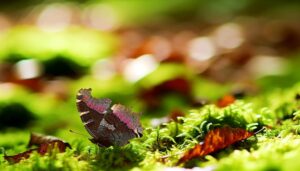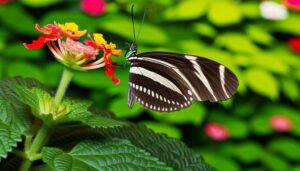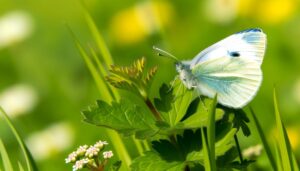Mourning Cloak Butterfly Life Cycle Overview
The life cycle of the Mourning Cloak Butterfly (Nymphalis antiopa) comprises four distinct stages: egg, larva, pupa, and adult. Eggs are laid on host plants like willow, elm, and poplar, facilitating larval nourishment.
The caterpillars undergo five instars, marked by growth and molting, feeding on leaves and various organic materials. Mature larvae form a chrysalis in secure sites, undergoing significant transformations.
Eclosion sees the butterfly emerge, expanding its wings and preparing for flight. The adult stages exhibit vibrant coloration and behaviors, with a lifespan of up to 10 months, including hibernation.
There is more to discover in their remarkable journey.
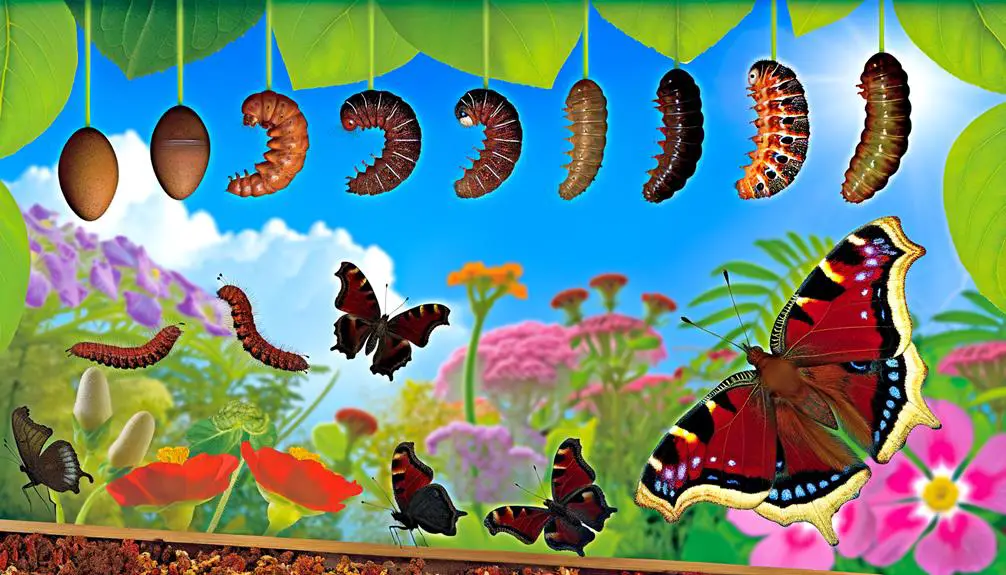
Key Takeaways
- The life cycle stages are eggs, caterpillars, pupae, and adults, each with distinct behaviors and physiological changes.
- Eggs are laid in clusters on the underside of host plant leaves, ensuring optimal larval development.
- Caterpillars undergo five instars, growing and molting while feeding primarily on willow, elm, and poplar leaves.
- Pupation involves forming a chrysalis with significant internal transformations, with the chrysalis providing camouflage and protection.
Egg Stage
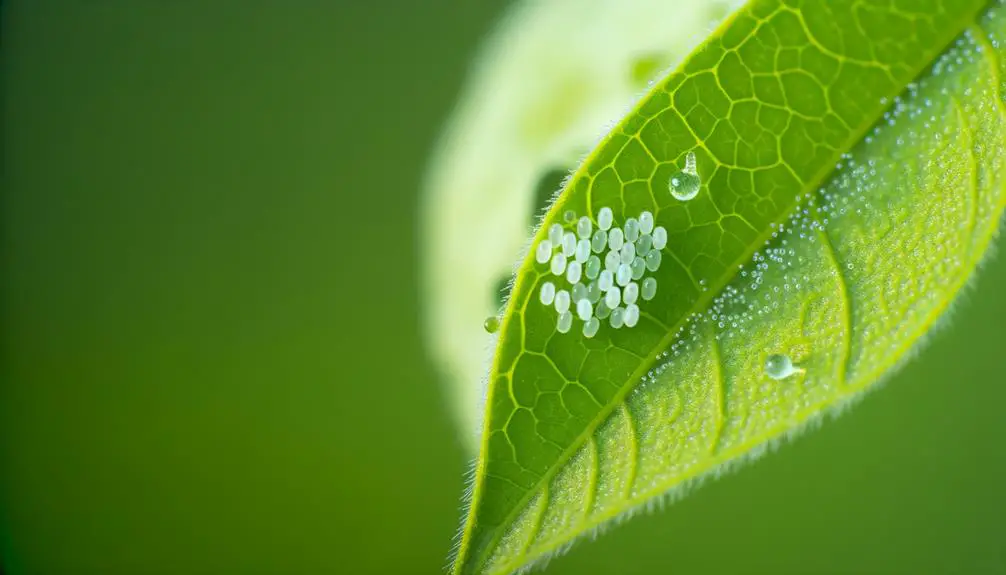
The egg stage of the Mourning Cloak butterfly (Nymphalis antiopa) begins when the female deposits her eggs on the underside of host plant leaves, typically willow, elm, or poplar. These ova are diminutive, spherical, and pale green, each measuring approximately 1 millimeter in diameter.
Arranged in tightly packed clusters, the eggs exhibit a ribbed texture, optimizing structural integrity. The embryonic development within the egg transpires over a period of 10 to 15 days, contingent upon ambient temperatures.
During this critical phase, the embryo undergoes segmentation and organogenesis. Environmental conditions such as humidity and temperature play a pivotal role in embryonic viability.
This initial stage establishes the foundation for subsequent larval growth, emphasizing the significance of precise microhabitat selection by the female.
Egg Laying Process
The egg laying process of the Mourning Cloak butterfly involves meticulous selection of egg sites and characteristic egg clustering behavior.
Typically, females choose host plants such as willow, elm, and poplar that provide ideal conditions for larval development.
Eggs are laid in tightly packed clusters, enhancing the likelihood of survival through synchronized hatching and collective feeding.
Choosing Egg Sites
Female Mourning Cloak butterflies meticulously select host plants that offer perfect conditions for the survival and development of their eggs.
Focusing on species such as willow (Salix), elm (Ulmus), and poplar (Populus), they seek plants that are both nutrient-rich and possess tender foliage. This guarantees prime nourishment for emerging larvae.
The selection process involves sensory evaluation through chemoreceptors located on the butterfly’s tarsi, which detect specific phytochemicals indicative of suitable oviposition sites.
By choosing locations with minimal predation risk and favorable microclimates, females maximize the likelihood of larval success.
These strategic choices are critical, as they directly influence the initial stages of the Mourning Cloak’s life cycle, dictating the survival rate and subsequent fitness of the offspring.
Egg Clustering Behavior
Having selected ideal host plants, Mourning Cloak butterflies engage in egg clustering behavior, a process where multiple eggs are laid in tight groups on the underside of leaves.
This strategic placement optimizes the chances of larval survival by providing immediate access to nutritious foliage upon hatching. The eggs, minute and cylindrical, are often arranged in neat, vertical rows, ensuring efficient space utilization.
This clustering not only minimizes predation risks but also facilitates synchronized hatching, essential for the collective feeding dynamics of the emerging larvae.
The choice of host plant, typically members of the Salicaceae family such as willows and poplars, underscores the butterfly’s evolutionary adaptation to specialized ecological niches, thereby enhancing reproductive success and species propagation.
Caterpillar Development
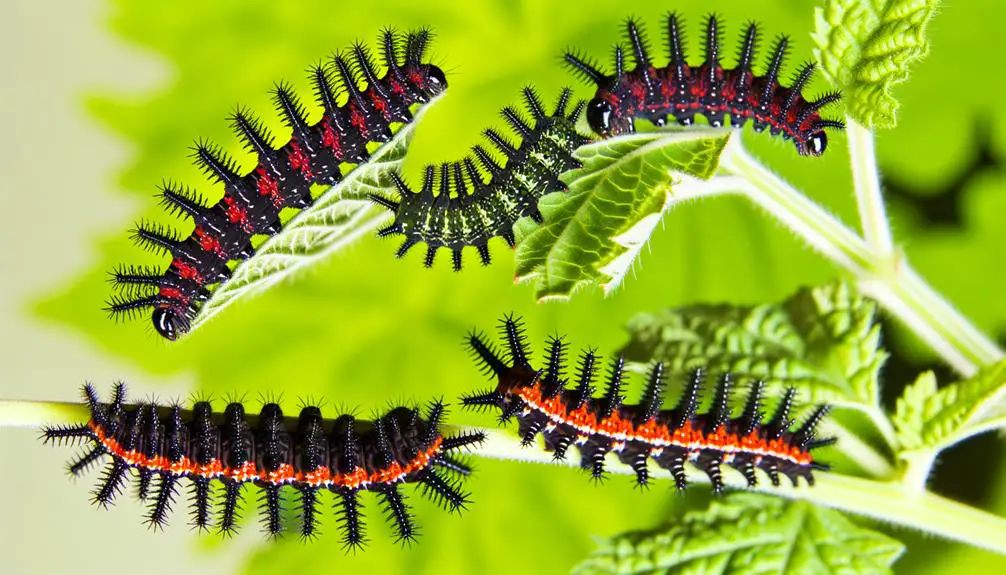
The caterpillar development of the Mourning Cloak butterfly encompasses distinct growth stages, from initial instar to final molting.
During this period, larvae exhibit specific feeding behaviors, primarily consuming leaves from host plants like willow and elm.
Habitat selection is critical, as caterpillars seek environments that provide both ample food resources and protection from predators.
Growth Stages Overview
During the caterpillar stage, Mourning Cloak butterflies undergo a series of instars, each marked by molting and significant increases in size.
Initially, the larvae emerge from eggs as small, black caterpillars adorned with spiny bristles.
Through successive instars, these caterpillars experience exponential growth, shedding their exoskeletons to accommodate their expanding bodies.
Particularly, each instar is characterized by increased pigmentation and more pronounced spines, which provide a defensive mechanism against predators.
This developmental phase, typically spanning two to four weeks, is critical for accumulating the necessary energy reserves required for metamorphosis.
Detailed documentation of these stages reveals the intricacies of their growth, underscoring the caterpillar’s transformation from a vulnerable larva to a robust, pupation-ready organism.
Feeding and Habitat
Consistently favoring host plants like willows, elms, and poplars, Mourning Cloak caterpillars exhibit highly specialized feeding behaviors that guarantee excellent growth and development. These larvae demonstrate a remarkable adaptation to their environment, selecting foliage that provides prime nutritional content. Their feeding patterns are methodical, often consuming leaves in a sequential manner to maximize nutrient intake.
| Host Plant | Nutrients Provided | Habitat Characteristics |
|---|---|---|
| Willows | Nitrogen, Proteins | Moist, riparian zones |
| Elms | Carbohydrates | Urban and rural areas |
| Poplars | Minerals, Sugars | Forested regions |
| Birch | Tannins, Amino Acids | Mixed woodlands |
| Hackberry | Vitamins, Fiber | Dry, rocky terrains |
This meticulous selection of host plants guarantees that Mourning Cloak caterpillars thrive in diverse habitats, reflecting their adaptive resilience and ecological specificity.
Feeding Habits
Frequently observed feeding on tree sap, the Mourning Cloak butterfly exhibits a diverse diet that includes nectar, rotting fruit, and even dung.
This dietary versatility allows it to thrive in various environments, especially during periods when floral nectar is scarce.
The butterfly’s proboscis, a specialized feeding organ, is adept at extracting nutrients from these diverse sources.
Significantly, the Mourning Cloak’s preference for tree sap, particularly from oak and willow species, provides crucial carbohydrates during early spring when other food sources are limited.
Additionally, the consumption of rotting fruit and dung supplies essential minerals and amino acids.
This broad spectrum of feeding habits underscores the species’ adaptability and resilience, contributing to its widespread distribution and ecological success.
Growth and Molting
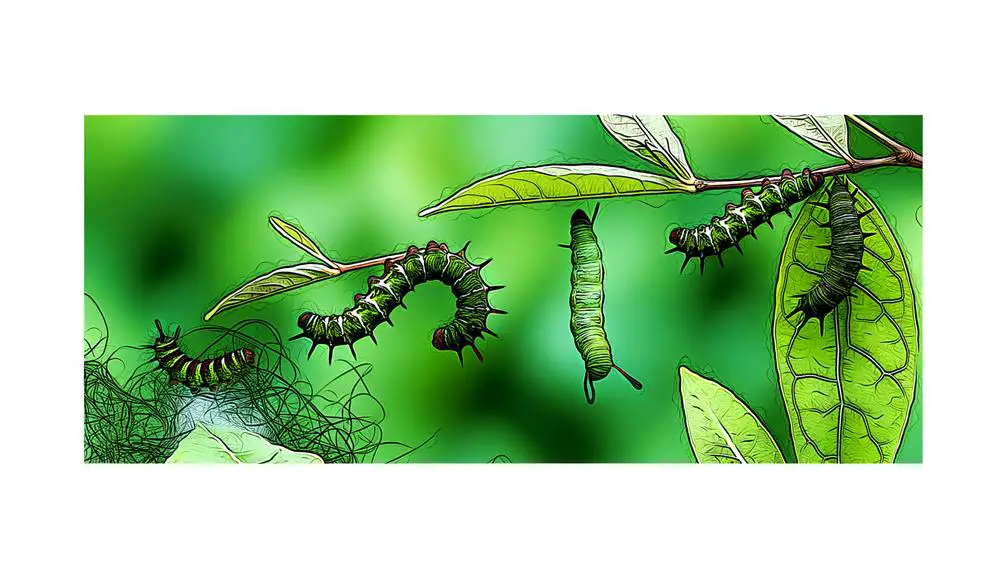
The growth and molting process in the Mourning Cloak butterfly involves distinct stages of development, characterized by periodic shedding of the exoskeleton, known as ecdysis.
During its larval phase, the caterpillar undergoes multiple instars, each marked by molting to accommodate its increasing size.
The frequency of these molts is contingent upon environmental factors and nutrient intake, ensuring ideal growth conditions.
Stages of Development
During its life cycle, the Mourning Cloak butterfly undergoes distinct stages of growth and molting, each marked by significant physiological changes.
Initially, the eggs hatch into larvae, commonly known as caterpillars, which proceed through five instars. Each instar signifies a phase between molts where the larva increases in size and complexity. The exoskeleton, a rigid structure, must be shed to accommodate growth, a process termed ecdysis.
Post the final instar, the larva forms a chrysalis, entering the pupal stage where metamorphosis occurs. Within the chrysalis, extensive cellular reorganization transpires, transforming the caterpillar into an adult butterfly.
This transformation is governed by precise hormonal regulation, ensuring successful development through each critical stage.
Molting Frequency
Molting in Mourning Cloak caterpillars occurs five times throughout their larval stage, each molt facilitating vital growth and development.
During these ecdyses, the caterpillar sheds its exoskeleton to accommodate increased body mass and morphological changes. The intervals between molts, termed instars, are characterized by significant feeding and energy accumulation, fundamental for the impending metamorphosis.
Post-molt, caterpillars exhibit rapid expansion due to the intake of air and fluids, solidifying their new exoskeleton. Hormonal regulation, particularly involving ecdysone, orchestrates these molting events, ensuring synchronized development.
Observational data indicate that each subsequent molt reveals enhanced pigmentation and structural complexity, preparing the organism for its pupal stage. This precise molting regimen underpins the Mourning Cloak’s successful shift to adulthood.
Pupa Formation
As the larvae of the Mourning Cloak Butterfly mature, they initiate the process of pupation by seeking a secure location to undergo this critical transformation. This phase marks a pivotal juncture in their life cycle, wherein they suspend themselves in a head-down position, using silk threads spun from specialized glands. The larvae then undergo a final molt, revealing the chrysalis beneath the old skin. This chrysalis will serve as a protective casing through the metamorphic process.
| Stage | Description |
|---|---|
| Larvae Maturing | Growth completion, preparation for pupation |
| Site Selection | Secure location chosen for transformation |
| Silk Attachment | Larvae suspend using silk threads |
| Final Molt | Shedding of old skin, chrysalis revealed |
| Chrysalis Formation | Protective casing for metamorphosis |
This meticulous process underscores the intricacies of Lepidopteran development.
Chrysalis Characteristics
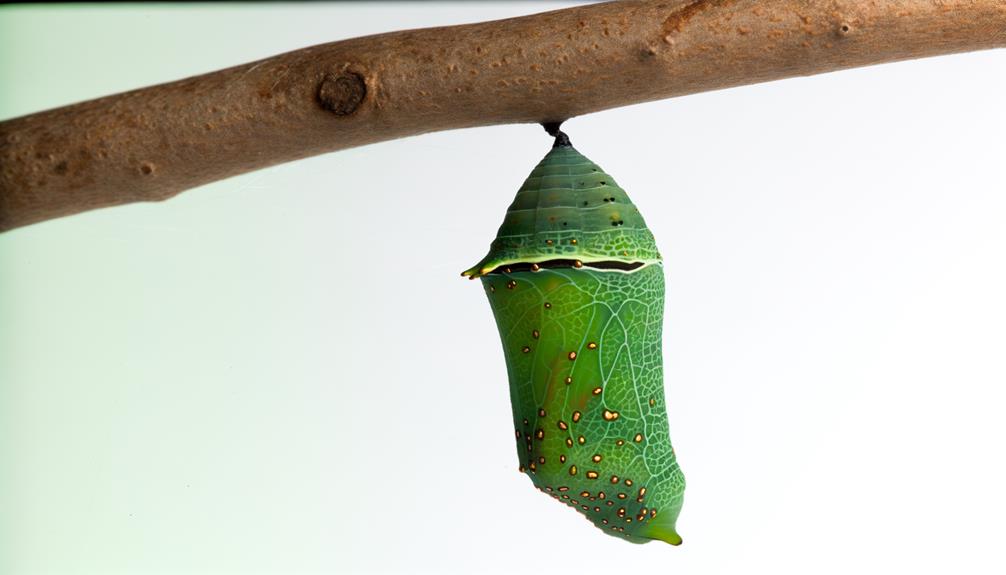
The chrysalis of the Mourning Cloak Butterfly exhibits a hardened exterior, providing both physical protection and an ideal microenvironment for the complex metamorphic processes occurring within.
Encasing the pupa, the chrysalis undergoes significant biochemical transformations, enabling the reorganization of larval structures into adult morphology.
Typically, the chrysalis displays a muted brown or green coloration, featuring minute spines and ridges that enhance camouflage against predators.
Internally, histolysis and histogenesis occur, where larval tissues break down and adult structures, such as wings and reproductive organs, develop.
This phase is marked by a cessation of feeding, relying entirely on stored energy reserves.
The chrysalis, often suspended from a secure substrate, remains motionless, signifying its critical role in the butterfly’s development.
Emergence Process
Upon completion of metamorphosis, the Mourning Cloak Butterfly initiates eclosion, breaking free from the chrysalis with carefully coordinated movements. This process involves a series of intricate physiological and behavioral steps essential for successful emergence. The butterfly uses peristaltic contractions to rupture the chrysalis, followed by systematic expansion of its wings through hemolymph infusion.
Key factors influencing eclosion include:
- Temperature Regulation: Ideal ambient temperatures expedite the eclosion process.
- Hydration Levels: Sufficient internal hydration is vital for wing expansion.
These factors collectively guarantee the Mourning Cloak Butterfly’s shift from a pupa to its adult form, ready to commence on subsequent life stages.
Adult Butterfly
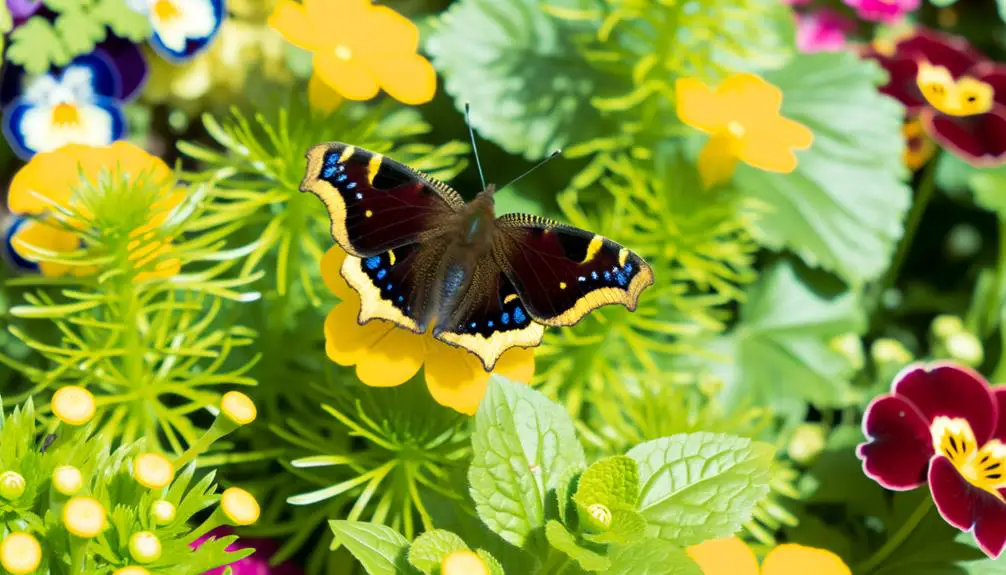
Once eclosion is complete, the Mourning Cloak Butterfly begins its adult phase, characterized by immediate behaviors such as wing drying and initial flight attempts. This period is essential for the butterfly to expand and harden its wings, facilitated by hemolymph pumping.
The wings, initially crumpled, achieve full extension within hours. Pigmentation becomes more vivid, revealing the characteristic dark maroon hue with iridescent blue spots and yellow borders.
The adult Mourning Cloak is primarily a diurnal creature, relying on its acute vision and sensitive antennae for navigation and feeding. Its proboscis, a highly specialized feeding organ, unfurls to sip nectar from a variety of floral sources.
These early stages of adulthood are integral for establishing territorial dominance and locating mates.
Lifespan and Behavior
Despite its delicate appearance, the Mourning Cloak Butterfly exhibits a relatively long lifespan, often surviving up to 10 months, which is considerably extended compared to many other butterfly species. This longevity is attributed to its unique hibernation behaviors and physiological adaptations.
- Hibernation: The Mourning Cloak enters diapause during winter months, enabling it to withstand cold temperatures.
- Feeding: Its diet mainly consists of tree sap and rotting fruit, providing essential nutrients for prolonged survival.
- Territoriality: Males exhibit aggressive territorial behavior, defending their domain from intruding rivals to secure mating opportunities.
These behaviors not only contribute to their extended lifespan but also highlight the butterfly’s resilience and strategic survival mechanisms. Understanding these aspects reveals the intricate balance and adaptability inherent in the Mourning Cloak’s life cycle.
What Eats The Mourning Cloak Butterfly?
Mourning cloak butterflies (Nymphalis antiopa) are not currently listed as endangered or threatened. They are widely distributed across North America and Eurasia, and while they face some threats common to many butterfly species, their populations are generally stable.
However, in specific regions like Armenia, they have been assessed as Near Threatened due to limited habitat and population data.
Conclusion
The mourning cloak butterfly (Nymphalis antiopa) exhibits a fascinating life cycle marked by distinct developmental stages, from egg to adult. After hatching, the larvae, known as caterpillars, feed on the leaves of willow, elm, and poplar trees before forming a chrysalis. Upon emerging as adults, these butterflies display deep burgundy wings with bright yellow edges, aiding in camouflage and predator avoidance. Another butterfly similar to mourning cloak is the Compton tortoiseshell, which also has a striking wing pattern and hibernates through the winter.
Particularly, the survival rate from egg to adult butterfly is remarkably low, with only about 1-2% of eggs reaching maturity.
This statistic underscores the precarious nature of their existence and highlights the ecological challenges faced by this species.
Understanding these developmental processes and survival rates provides critical insights into conservation strategies for maintaining butterfly populations.

